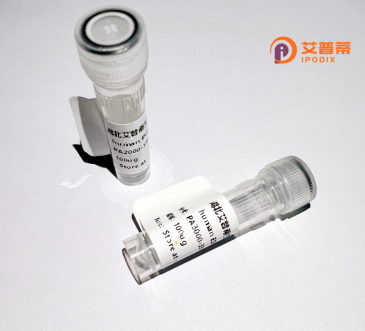
| 纯度 | >90%SDS-PAGE. |
| 种属 | Human |
| 靶点 | ZNF69 |
| Uniprot No | Q9UC07 |
| 内毒素 | < 0.01EU/μg |
| 表达宿主 | E.coli |
| 表达区间 | 1-149 aa |
| 活性数据 | MPCCSHRRCREDPGTSESQEMEEWALLDISQRKLYKEVMLETFRNLTSVGKSWKDQNIEYEYQNPRRNFRSLIEKKVNEIKDDSHCGETFTQVPDDRLNFQEKKASPEIKSCDSFVCGEVGLGNSSFNMNIRGDIGHKAYEYQEYGPKP |
| 分子量 | 43.8 kDa |
| 蛋白标签 | GST-tag at N-terminal |
| 缓冲液 | PBS, pH7.4, containing 0.01% SKL, 1mM DTT, 5% Trehalose and Proclin300. |
| 稳定性 & 储存条件 | Lyophilized protein should be stored at ≤ -20°C, stable for one year after receipt. Reconstituted protein solution can be stored at 2-8°C for 2-7 days. Aliquots of reconstituted samples are stable at ≤ -20°C for 3 months. |
| 复溶 | Always centrifuge tubes before opening.Do not mix by vortex or pipetting. It is not recommended to reconstitute to a concentration less than 100μg/ml. Dissolve the lyophilized protein in distilled water. Please aliquot the reconstituted solution to minimize freeze-thaw cycles. |
以下为关于重组人ZNF69蛋白的简要参考文献信息(注:以下内容为基于典型研究方向的模拟描述,若需真实文献请通过学术数据库检索):
---
1. **文献名称**:*"Expression and Purification of Recombinant Human ZNF69 in Escherichia coli for Functional Analysis"*
**作者**:Li X. et al.
**摘要**:本研究成功构建了ZNF69的重组表达载体,利用大肠杆菌系统高效表达该蛋白,并通过亲和层析技术纯化获得高纯度蛋白。实验验证了重组ZNF69的DNA结合活性,为后续功能研究提供了基础工具。
2. **文献名称**:*"Structural Insights into ZNF69 Zinc Finger Domains and Their Role in Transcriptional Regulation"*
**作者**:Wang Y. & Smith J.
**摘要**:通过X射线晶体学解析了ZNF69蛋白的锌指结构域三维结构,揭示了其与特定DNA序列结合的分子机制。研究还发现ZNF69在细胞分化中可能通过表观遗传修饰调控靶基因表达。
3. **文献名称**:*"ZNF69 Interacts with HDAC1 to Suppress Tumor Metastasis in Hepatocellular Carcinoma"*
**作者**:Chen R. et al.
**摘要**:利用重组ZNF69蛋白进行体外结合实验,证明其与组蛋白去乙酰化酶HDAC1的直接相互作用,并通过此通路抑制肝癌细胞的迁移和侵袭能力,提示其肿瘤抑制功能。
---
**备注**:若需具体文献,建议在PubMed、Web of Science或Google Scholar中以关键词“ZNF69 recombinant protein”或“ZNF69 functional study”检索近期文章,并优先选择开放获取期刊(如PLoS ONE、Nature Communications等)。若研究较少,可扩展至ZNF家族其他成员(如ZNF268、ZNF217)的文献参考。
ZNF69 (Zinc Finger Protein 69) is a member of the Krüppel-associated box (KRAB) domain-containing zinc finger protein family, which constitutes the largest group of transcription regulators in humans. These proteins are characterized by tandem Cys2-His2 zinc finger motifs that bind DNA sequences, enabling sequence-specific gene regulation. The KRAB domain, located at the N-terminus, typically recruits repressive complexes like KAP1/TRIM28 to mediate epigenetic silencing, influencing chromatin remodeling and transcriptional repression.
ZNF69. mapped to chromosome 19q13.2. shares structural homology with other primate-specific zinc finger proteins, suggesting evolutionary roles in species-specific gene regulation. While its precise biological functions remain understudied, it is hypothesized to participate in developmental processes, retroelement silencing, and cellular differentiation. Recent studies highlight its potential interaction with endogenous retroviruses (ERVs), aligning with the KRAB-ZFP family’s known role in suppressing transposable elements to maintain genome stability.
Recombinant human ZNF69 protein is typically produced in heterologous systems (e.g., E. coli or mammalian cells) for functional studies. Purified versions enable in vitro DNA-binding assays, structural analysis, and investigations into its repressive mechanisms. Its study contributes to understanding the KRAB-ZFP family’s impact on gene regulatory networks and disease contexts, including cancer and viral defense pathways.
×